Effect of Geographic Regions on the Flavor Quality and Non-Volatile Compounds of Chinese Matcha
Abstract
1. Introduction
2. Materials and Methods
2.1. Materials
2.2. Instruments
2.3. Matcha Processing Methods in Different Regions
2.4. Sensory Evaluation of Matcha Sample
2.5. Sample Preparation
2.6. Liquid Chromatography Conditions
2.7. Mass Spectrum Conditions
2.8. Data Processing
3. Results
3.1. Sensory Quality Analysis of Different Geographic Regions of Matcha
3.2. Cluster Analysis of Non-Volatile Substances of Matcha from Different Geographic Regions
3.3. PCA of Non-Volatile Substances of Matcha from Different Geographic Regions
3.4. Metabolic Profile Analysis of Differential Non-Volatile Substances of Matcha (Z1 vs. Z2, R as the Control)
3.5. Metabolic Profile Analysis of Differential Non-Volatile Substances of Matcha (G vs. H, R as the Control)
4. Conclusions
5. Discussion
Supplementary Materials
Author Contributions
Funding
Data Availability Statement
Conflicts of Interest
References
- Huang, D.; Chen, X.; Tan, R.; Wang, H.; Jiao, L.; Tang, H.; Zong, Q.; Mao, Y. A comprehensive metabolomics analysis of volatile and non-volatile compounds in matcha processed from different tea varieties. Food Chem. X 2024, 21, e101234. [Google Scholar]
- Kurauchi, Y.; Devkota, H.P.; Hori, K.; Nishihara, Y.; Hisatsune, A.; Seki, T.; Katsuki, H. Anxiolytic activities of Matcha tea powder, extracts, and fractions in mice: Contribution of dopamine D1 receptor and serotonin 5HT1A receptor mediated mechanisms. J. Funct. Foods 2019, 59, 301–308. [Google Scholar] [CrossRef]
- Baba, Y.; Kaneko, T.; Tihara, A.T. Matcha consumption maintains attenuation function following a mild acute psychological stress without affecting a feeling of fatigue: A randomized placebo controlled study in young adults. Nutr. Res. 2021, 88, 44–52. [Google Scholar] [CrossRef]
- Dietz, C.; Dekker, M.; Piqueras, F.B. An intervention study on the effect of matcha tea, in drink and snack bar formats, on mood and cognitive performance. Food Res. Int. 2017, 99, 72–83. [Google Scholar] [CrossRef] [PubMed]
- Unno, K.; Furushima, D.; Hamamoto, S.; Iguchi, K.; Yamada, H.; Morita, A.; Horie, H.; Nakamura, Y. Stress-reducing effect of cookies containing matcha green tea: Essential ratio among theanine, arginine, caffeine and epigallocatechin gallate. Heliyon 2019, 5, e01653. [Google Scholar] [CrossRef] [PubMed]
- Bonuccelli, G.; Sotgia, F.; Lisanti, M.P. Matcha green tea (MGT) inhibits the propagation of cancer stem cells (CSCs), by targeting mitochondrial metabolism, glycolysis and multiple cell signalling pathways. Aging 2018, 10, 1867–1883. [Google Scholar] [CrossRef] [PubMed]
- Schröder, L.; Marahrens, P.; Koch, J.G.; Heidegger, H.; Vilsmeier, T.; Phan-Brehm, T.; Hofmann, S.; Mahner, S.; Jeschke, U.; Richter, D.U. Effects of green tea, matcha tea and their components epigallocatechin gallate and quercetin on MCF-7 and MDA-MB-231 breast carcinoma cells. Oncol. Rep. 2019, 41, 387–396. [Google Scholar] [PubMed]
- Li, G.; Zhang, J.; Cui, H.; Feng, Z.; Gao, Y.; Wang, Y.; Chen, J.; Xu, Y.; Niu, D.; Yin, J. Research progress on the effect and mechanism of tea products with different fermentation degrees in regulating type 2 diabetes mellitus. Foods 2024, 13, 221. [Google Scholar] [CrossRef] [PubMed]
- Elisa, P.; Susanna, D.P.; Irene, S.; Sara, C.; Chiara, F.; Laura, D.G.; Laura, D.; Luca, S. Evaluation of the antiglycative and antioxidant activities of matcha tea. Nat. Prod. Res. 2024. online ahead of print. [Google Scholar]
- Ryoma, N.; Ayami, T.; Kengo, M.; Naoki, N.; Tsuyoshi, I.; Hideki, T.; Yorimasa, O. Multimodal inhibitory effect of matcha on Porphyromonas gingivalis. Microbiol. Spectr. 2024, 12, e0342623. [Google Scholar]
- Reygaert, W.C. Green tea catechins: Their use in treating and preventing infectious diseases. BioMed Res. Int. 2018, 2018, 9105261. [Google Scholar] [CrossRef]
- Ouyang, Q.; Wang, L.; Park, B.; Kang, R.; Wang, Z.; Chen, Q.; Guo, Z. Assessment of matcha sensory quality using hyperspectral microscope imaging technology. LWT-Food Sci. Technol. 2020, 125, e109254. [Google Scholar] [CrossRef]
- Huang, Y.; Goh, R.M.V.; Aileen, P.; Liu, S.Q.; Sakumoto, S.; Oh, H.Y.; Kim, H.E.; Sun, J.; Lassabliere, B.; Yu, B. Effect of three milling processes (cyclone-, bead- and stone-millings) on the quality of matcha: Physical properties, taste and aroma. Food Chem. 2022, 372, e131202. [Google Scholar]
- Ruan, J.; Haerdter, R.; Gerendas, J. Impact of nitrogen supply on carbon/nitrogen allocation: A case study on amino acids and catechins in green tea [Camellia sinensis (L.) O. Kuntze] plants. Plant Biol. 2010, 12, 724–734. [Google Scholar] [CrossRef]
- Zhang, H.; Li, Y.; Lv, Y.; Jiang, Y.; Pan, J.; Duan, Y.; Zhu, Y.; Zhang, S. Influence of brewing conditions on taste components in Fuding white tea infusions. J. Sci. Food Agric. 2017, 97, 2826–2833. [Google Scholar] [CrossRef] [PubMed]
- Ku, K.M.; Choi, J.N.; Kim, J.; Kim, J.K.; Yoo, L.G.; Lee, S.J.; Hong, Y.-S.; Lee, C.H. Metabolomics analysis reveals the compositional differences of shade grown tea (Camellia sinensis L.). J. Agric. Food Chem. 2010, 58, 418–426. [Google Scholar] [CrossRef]
- Zhang, L.; Cao, Q.-Q.; Granato, D.; Xu, Y.-Q.; Ho, C.-T. Association between chemistry and taste of tea: A review. Trends Food Sci. Technol. 2020, 101, 139–149. [Google Scholar] [CrossRef]
- Horie, H.; Ema, K.; Nishikawa, H.; Nakamura, Y. Comparison of the chemical components of powdered green tea sold in the US. Jpn. Agric. Res. Q. 2018, 52, 143–147. [Google Scholar] [CrossRef]
- Hu, J.H.; Chen, Y.Q.; Ni, D.J. Effect of superfine grinding on quality and antioxidant property of fine green tea powders. LWT-Food Sci. Technol. 2012, 45, 8–12. [Google Scholar] [CrossRef]
- Jakubczyk, K.; Kochman, J.; Kwiatkowska, A.; Kałduńska, J.; Dec, K.; Kawczuga, D.; Janda, K. Antioxidant properties and nutritional composition of Matcha green tea. Foods 2020, 9, 483–492. [Google Scholar] [CrossRef] [PubMed]
- Narukawa, M.; Noga, C.; Ueno, Y.; Sato, T.; Misaka, T.; Watanabe, T. Evaluation of the bitterness of green tea catechins by a cell-based assay with the human bitter taste receptor hTAS2R39. Biochem. Biophys. Res. Commun. 2011, 405, 620–625. [Google Scholar] [CrossRef]
- Yamazaki, T.; Narukawa, M.; Mochizuki, M.; Misaka, T.; Watanabe, T. Activation of the hTAS2R14 human bitter taste receptor by (−)-epigallocatechin gallate and (−)-epicatechin gallate. Biosci. Biotechnol. Biochem. 2013, 77, 1981–1983. [Google Scholar] [CrossRef] [PubMed]
- Soares, S.; Kohl, S.; Thalmann, S.; Mateus, N.; Meyerhof, W.; De Freitas, V. Different phenolic compounds activate distinct human bitter taste receptors. J. Agric. Food Chem. 2013, 61, 1525–1533. [Google Scholar] [CrossRef]
- Chandrashekar, J.; Mueller, K.L.; Hoon, M.A.; Adler, E.; Feng, L.; Guo, W.; Zuker, C.S.; Ryba, N.J. T2Rs function as bitter taste receptors. Cell 2000, 100, 703–711. [Google Scholar] [CrossRef] [PubMed]
- Changdhari, N.; Roper, S.D. The cell biology of taste. J. Cell Biol. 2010, 190, 285–296. [Google Scholar] [CrossRef] [PubMed]
- Narukawa, M.; Misaka, T. Tas2r125 functions as the main receptor for detecting bitterness of tea catechins in the oral cavity of mice. Biochem. Biophys. Res. Commun. 2018, 503, 2301–2305. [Google Scholar] [CrossRef]
- Suess, B.; Brockhoff, A.; Merhof, W.; Hofmann, T. The Odor-ant (R)-Citronellal attenuates caffeine bitterness by inhibiting the bitter receptors TAS2R43 and TAS2R46. J. Agric. Food Chem. 2016, 66, 2301–2311. [Google Scholar] [CrossRef] [PubMed]
- Roland, W.S.U.; Gouka, R.J.; Gruppen, H.; Driesse, M.; van Buren, L.; Smit, G.; Vincken, J.-P. 6-Methoxyflavanones as bitter taste receptor blockers for hTAS2R39. PLoS ONE 2014, 9, e94451. [Google Scholar] [CrossRef] [PubMed]
- Cao, Q.-Q.; Zou, C.; Zhang, Y.-H.; Du, Q.-Z.; Yin, J.-F.; Shi, J.; Xue, S.; Xu, Y.-Q. Improving the taste of autumn green tea with tannase. Food Chem. 2019, 277, 432–437. [Google Scholar] [CrossRef]
- Xu, Y.-Q.; Zhang, Y.-N.; Chen, J.-X.; Wang, F.; Du, Q.-Z.; Yin, J.-F. Quantitative analyses of the bitterness and astringency of catechins from green tea. Food Chem. 2018, 258, 16–24. [Google Scholar] [CrossRef]
- Narukawa, M.; Arukawa, M.; Kimata, H.; Noga, C.; Watanabe, T. Taste characteristic of green tea catechins. Int. J. Food Sci. Technol. 2010, 45, 1579–1585. [Google Scholar] [CrossRef]
- Zhang, J.Y.; Cui, H.C.; Feng, Z.H.; Wang, W.W.; Zhao, Y.; Deng, Y.L.; Jiang, H.Y.; Yin, J.F.; Engelhardt, U.H. Bitterness quantification and simulated taste mechanism of theasinensin A from tea. Front. Nutr. 2023, 10, 1138023. [Google Scholar] [CrossRef] [PubMed]
- Li, S.; Tian, H.; Zhu, G.; Wei, Z. The application of untargeted metabolomics coupled with chemometrics for the analysis of agitation effects on the sensory profiles of matcha tea. Curr. Res. Food Sci. 2024, 9, e100843. [Google Scholar]
- Narukawa, M.; Toda, Y.; Nakagita, T.; Hayashi, Y.; Misaka, T. L-Theanine elicits umami taste via the T1R1 and T1R3 umami taste receptor. Amino Acids 2014, 46, 1583–1687. [Google Scholar] [CrossRef]
- Toda, Y.; Nakagita, T.; Hayakawa, T.; Okada, S.; Narukawa, M.; Imai, H.; Ishimaru, Y.; Misaka, T. Two distinct determinants of ligand specificity in T1R1/T1R3 (the umami taste receptor). J. Biol. Chem. 2013, 288, 36863–36877. [Google Scholar] [CrossRef] [PubMed]
- Ouyang, G.Q.; Yang, Y.; Park, B.; Kang, R.; Wu, J.; Chen, Q.; Guo, Z.; Li, H. A novel hyper-spectral microscope imaging technology for rapid evaluation of particle size distribution in matcha. J. Food Eng. 2020, 272, e109782. [Google Scholar] [CrossRef]
- Jiang, H.; Yu, F.; Qin, L.; Zhang, N.; Cao, Q.; Schwab, W.; Li, D.; Song, C. Dynamic change in amino acids, catechins, alkaloids, and gallic acid in six types of tea processed from the same batch of fresh tea (Camellia sinensis L.) leaves. Food Compos. Anal. 2019, 77, 28–38. [Google Scholar] [CrossRef]
- Zhang, J.; Mao, Y.; Xu, Y.; Feng, Z.; Wang, Y.; Chen, J.; Zhao, Y.; Cui, H.; Yin, J. Effect of isolated scenting process on the aroma quality of osmanthus Longjing tea. Foods 2024, 13, 2985–3002. [Google Scholar] [CrossRef]
- Naveed, M.; Hejazi, V.; Abbas, M.; Kamboh, A.A.; Khan, G.J.; Shumzaid, M.; Ahmad, F.; Babazadeh, D.; FangFang, X.; Modarresi-Ghazani, F.; et al. Chlorogenic acid (CGA): A pharmacological review and call for further research. Biomed. Pharmacother. 2017, 97, 67–74. [Google Scholar] [CrossRef] [PubMed]
- Li, D.; Park, B.; Kang, R.; Chen, Q.; Ouyang, Q. Quantitative prediction and visualization of matcha color physicochemical indicators using hyper-spectral microscope imaging technology. Food Control 2024, 163, e110531. [Google Scholar]
- Guo, Z.; Barimah, A.O.; Yin, L.; Chen, Q.; Shi, J.; El-Seedi, H.R.; Zou, X. Intelligent evaluation of taste constituents and polyphenols to amino acids ratio in matcha tea powder using near infrared spectroscopy. Food Chem. 2021, 353, 129372. [Google Scholar] [CrossRef] [PubMed]
- Yu, P.; Yeo, A.S.-L.; Low, M.-Y.; Zhou, W. Identifying key non-volatile compounds in ready-to-drink green tea and their impact on taste profile. Food Chem. 2014, 155, 9–16. [Google Scholar] [CrossRef] [PubMed]
- Koláčková, T.; Kolofiková, K.; Sytařová, I.; Snopek, L.; Sumczynski, D.; Orsavová, J. Matcha tea: Analysis of nutritional composition, phenolics and antioxidant activity. Plant Food Hum. Nutr. 2020, 75, 48–53. [Google Scholar] [CrossRef] [PubMed]
- Koláčková, T.; Sumczynski, D.; Zálešáková, L.; Šenkárová, L.; Orsavová, J.; Lanczová, N. Free and bound amino acids, minerals and trace elements in matcha (Camellia sinensis L.): A nutritional evaluation. J. Food Compos. Anal. 2020, 92, 103581–103598. [Google Scholar] [CrossRef]
- Yu, Z.M.; Yang, Z.Y. Understanding different regulatory mechanisms of proteinaceous and non-proteinaceous amino acid formation in tea (Camellia sinensis) provides new insights into the safe and effective alteration of tea flavor and function. Crit. Rev. Food Sci. Nutr. 2020, 60, 844–858. [Google Scholar] [CrossRef]
- GB/T 23776-2018; Methodology for Sensory Evaluation of Tea. Standardization Administration of the People’s Republic of China: Beijing, China, 2018.
- Tan, M.H.; Liu, Y.D.; Xu, Y.; Yan, G.; Zhou, N.; Chen, H.R.; Jiang, Z.Z.; Peng, L.Z. Plant-derived exosomes as novel nanotherapeutics contrive glycolysis reprogramming-mediated angiogenesis for diabetic ulcer healing. Biomater. Res. 2024, 28, 35. [Google Scholar] [CrossRef]
- Goto, T.; Horie, H.; Ozeki, Y.; Masuda, H.; Warashina, J. Chemical composition of Japanese green teas on market. Tea Res. J. 1994, 80, 23–28. [Google Scholar] [CrossRef][Green Version]
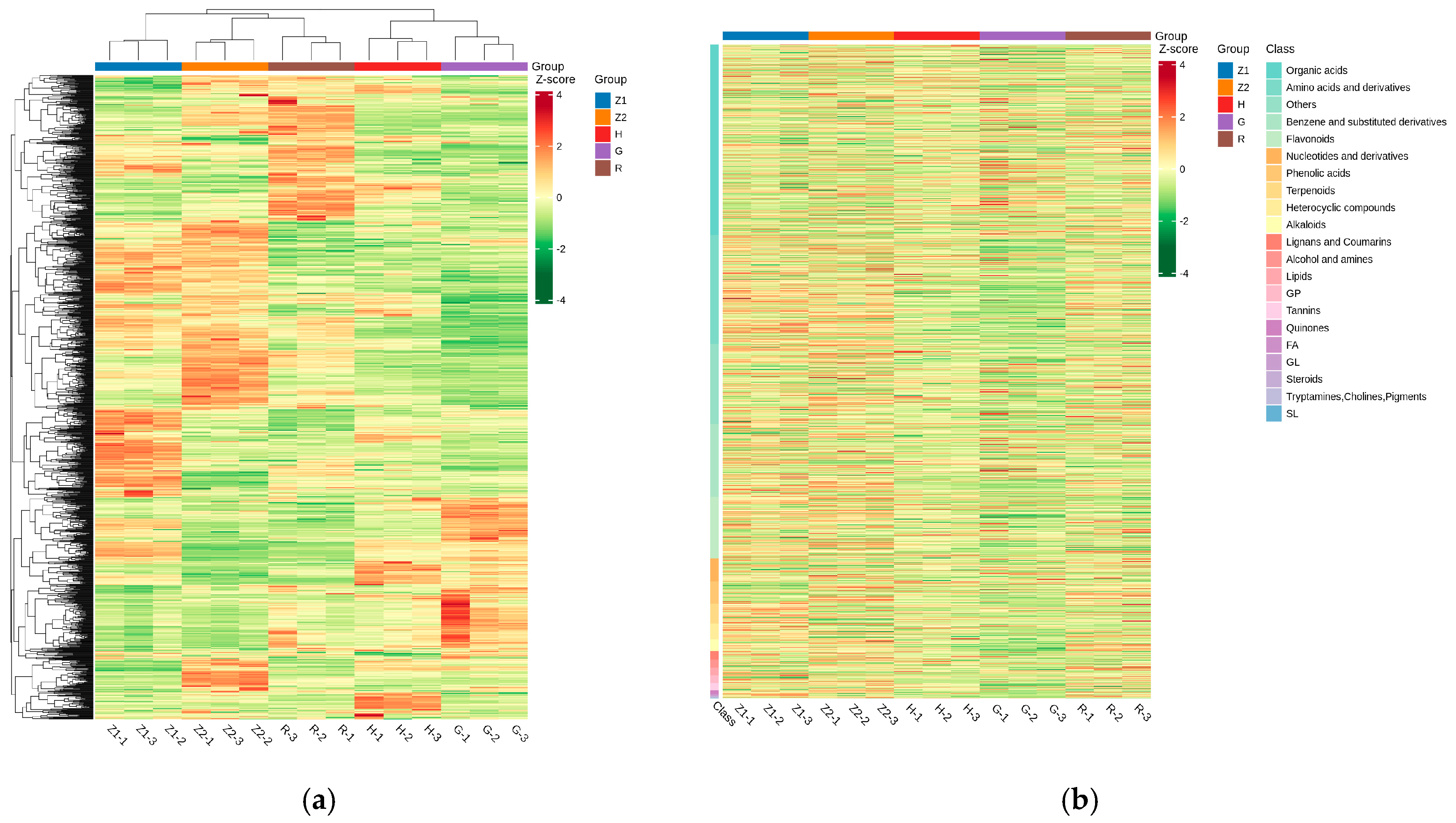
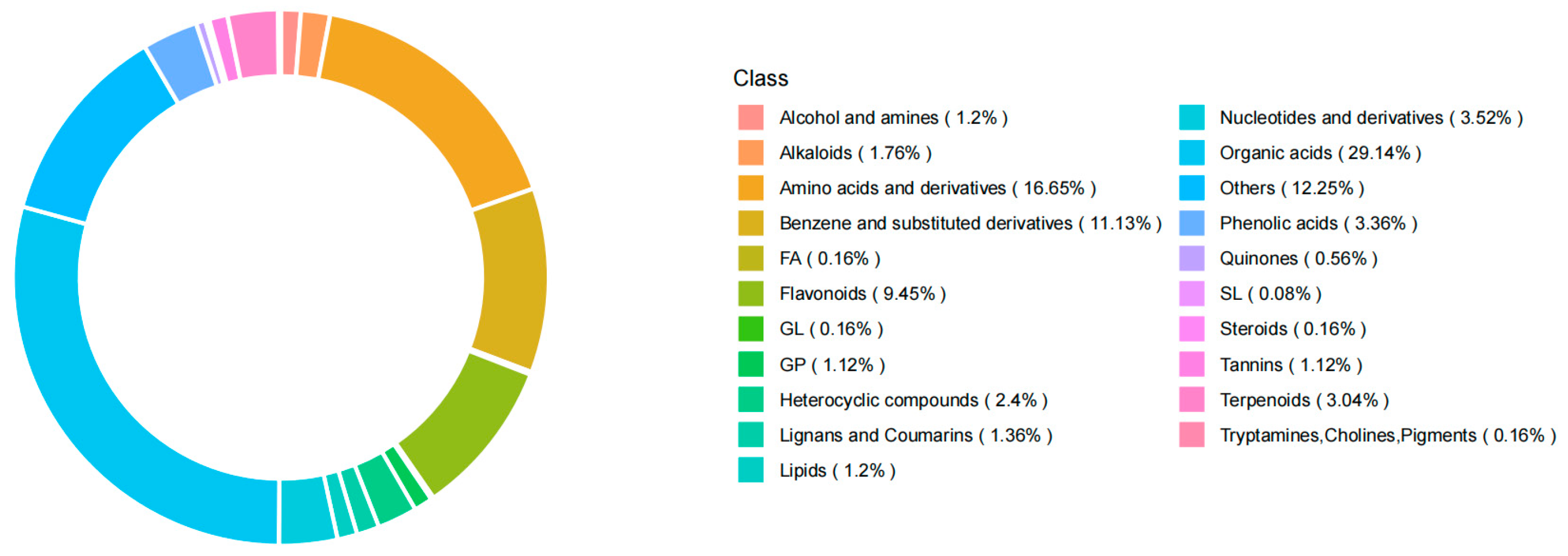
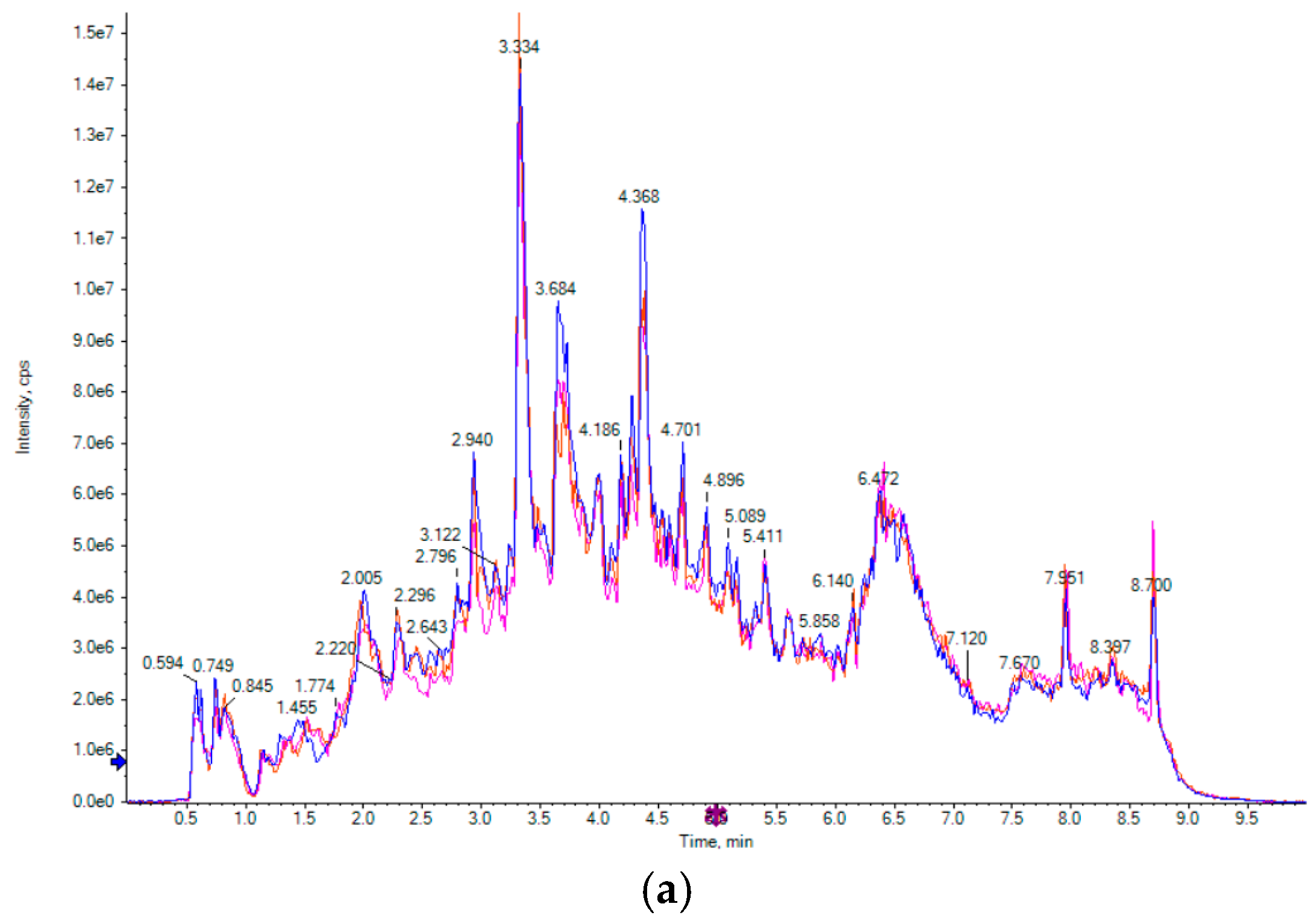

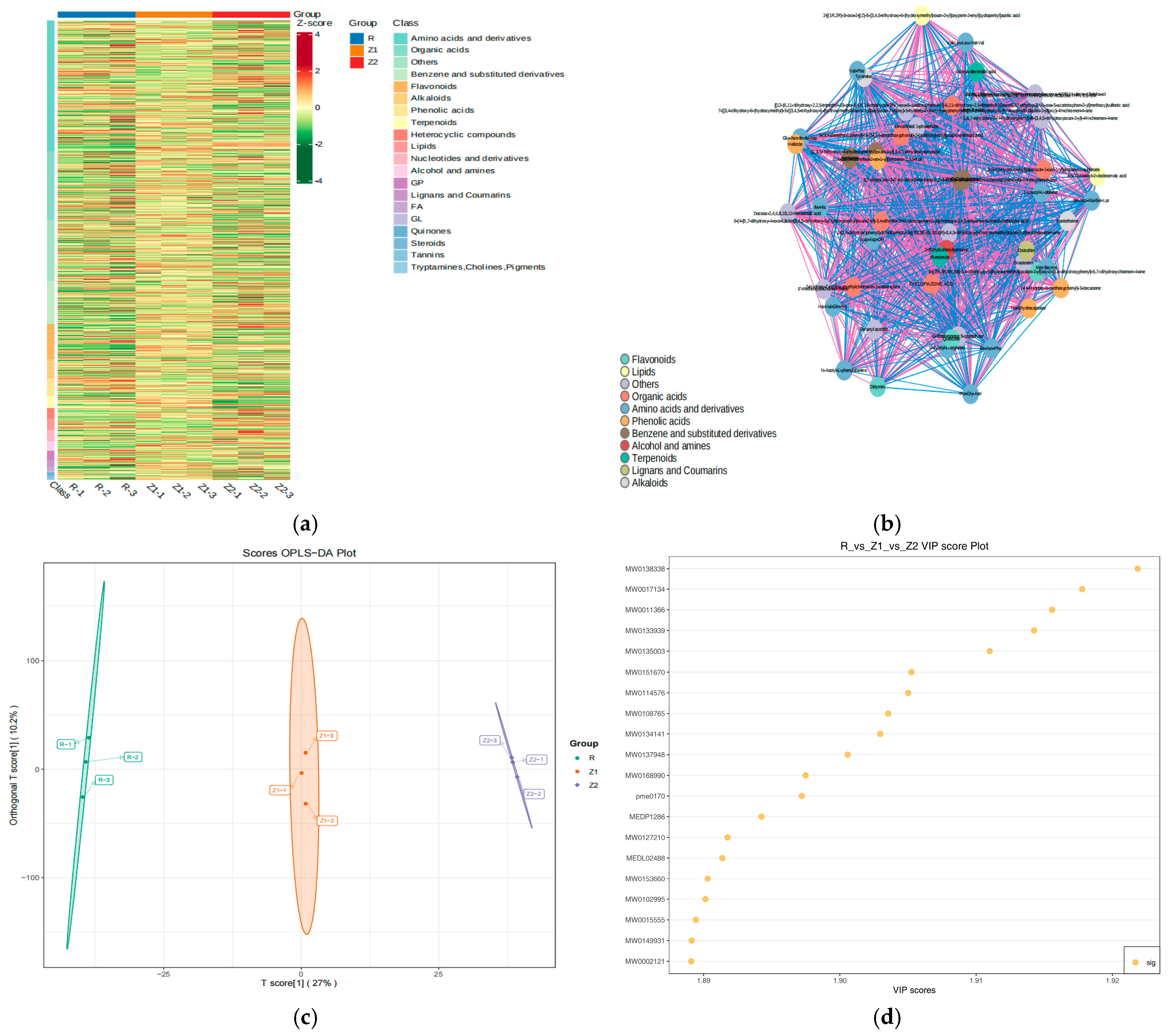
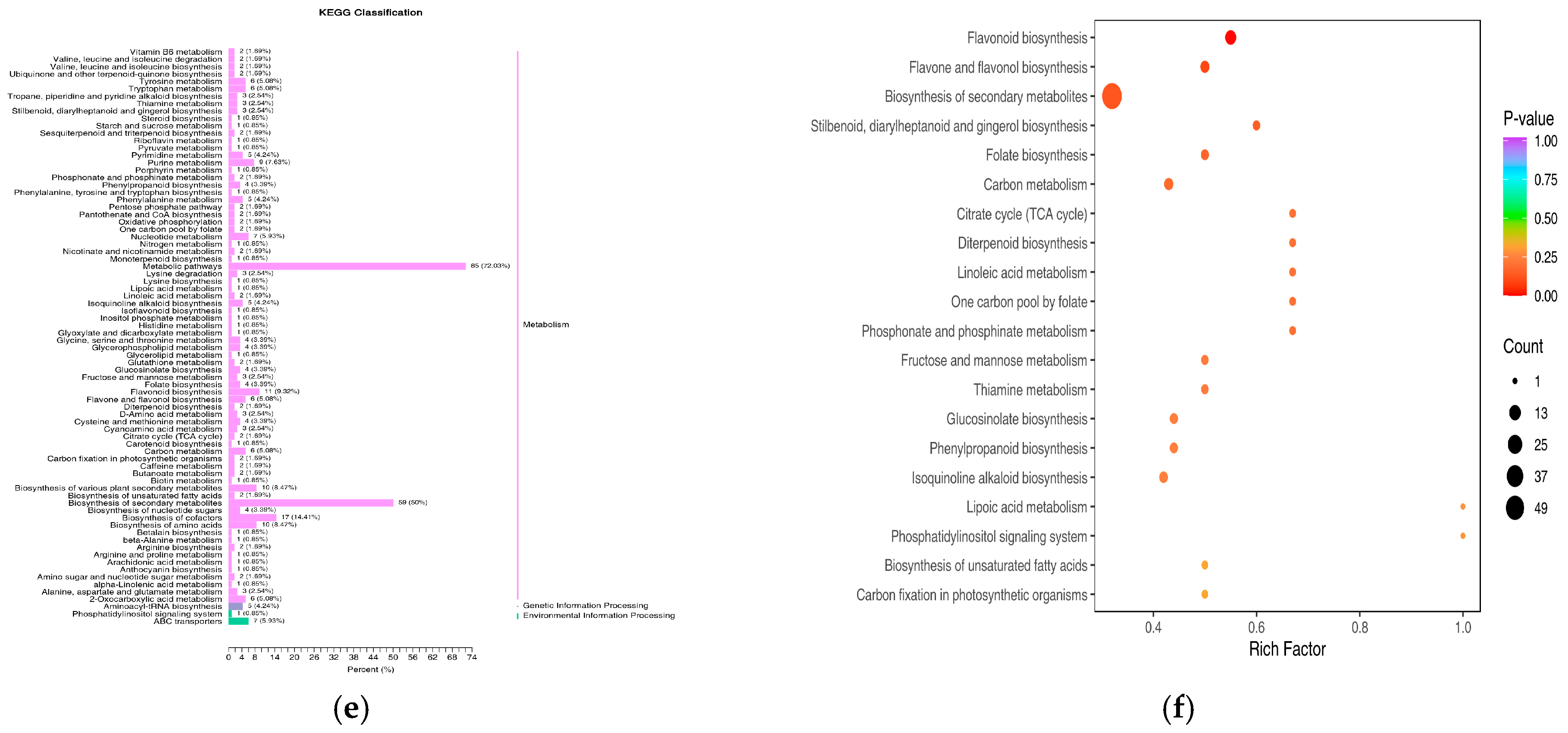
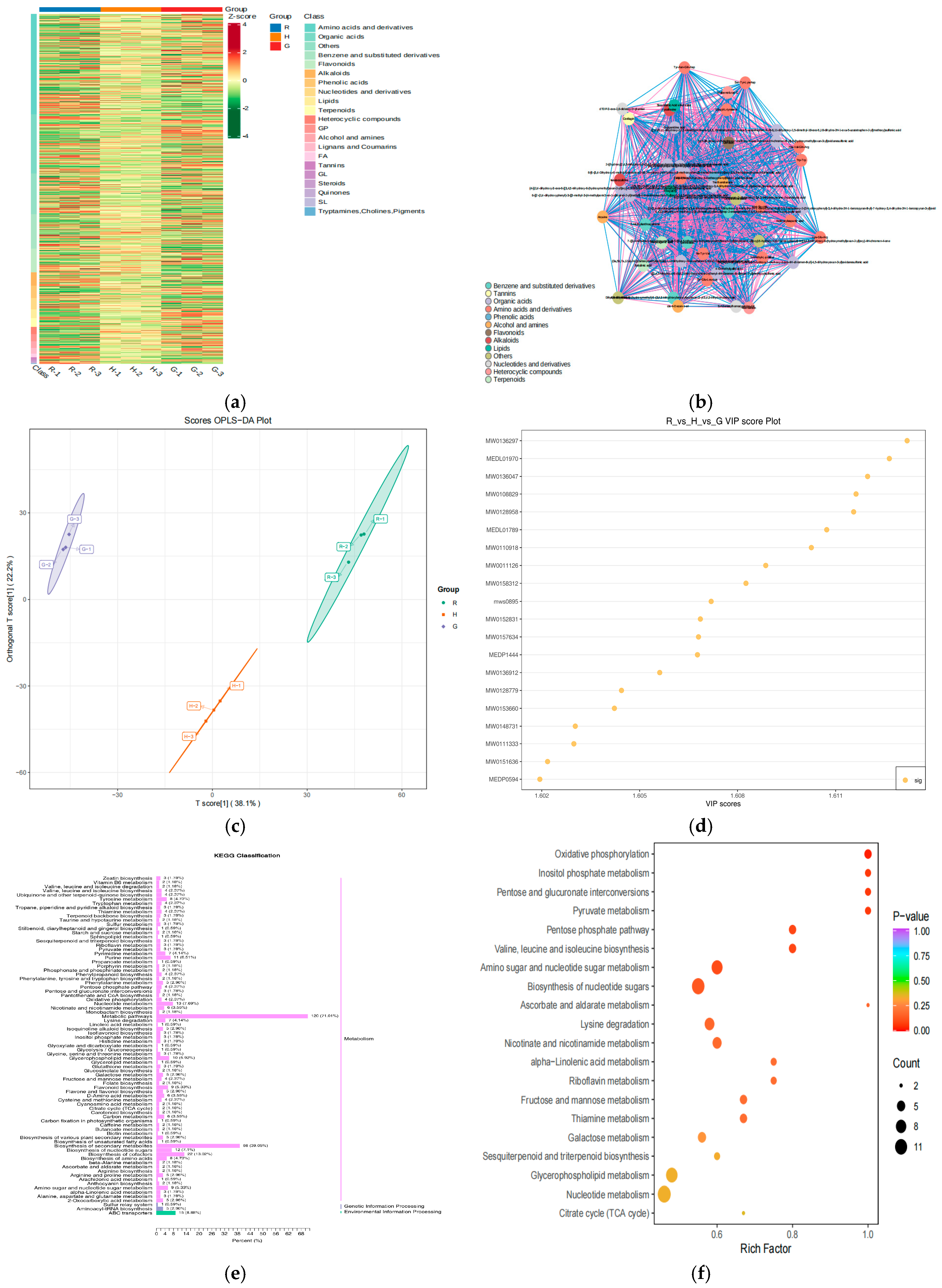
| Different Geographically Regional Matcha | Appearance (10%) | Liquor Color (20%) | Aroma (35%) | Taste (35%) | Total Quality Score | ||||
|---|---|---|---|---|---|---|---|---|---|
| Comment | Score | Comment | Score | Comment | Score | Comment | Score | ||
| Japan Shizuoka matcha (R) | delicate, even, vibrant green | 93.8 ± 0.6 a | more intense green | 94.3 ± 0.1 a | fresh, strong seaweed fragrance | 93.6 ± 0.7 a | thick, mellow, fresh | 94.1 ± 0.4 a | 93.5 ± 0.7 a |
| China Hangzhou matcha (Z1) | delicate, even, green | 91.3 ± 0.5 b | green | 91.1 ± 0.8 c | slight seaweed fragrance, slightly smoky | 85.2 ± 0.4 e | thick, coarse, bitter, astringent | 83.5 ± 0.3 c | 86.2 ± 0.4 c |
| China Wuyi matcha (Z2) | delicate, even, green | 91.1 ± 0.2 b | intense green | 92.5 ± 0.5 b | slight seaweed fragrance | 88.3 ± 0.2 c | thick, fresh, slightly bitter | 89.5 ± 0.6 b | 89.1 ± 0.2 b |
| China Enshi matcha (H) | delicate, even, tender green | 90.4 ± 0.3 b | intense green | 92.8 ± 0.2 b | fresh, seaweed fragrance | 91.5 ± 0.3 b | thick, fresh, slightly bitter | 90.2 ± 0.5 b | 90.7 ± 0.5 b |
| China Tongren matcha (G) | delicate, even, relatively tender green | 88.6 ± 0.4 c | green | 91.2 ± 0.6 c | slight seaweed fragrance | 86.8 ± 0.5 d | thick, bitter, slightly astringent | 84.5 ± 0.7 c | 86.5 ± 0.6 c |
Disclaimer/Publisher’s Note: The statements, opinions and data contained in all publications are solely those of the individual author(s) and contributor(s) and not of MDPI and/or the editor(s). MDPI and/or the editor(s) disclaim responsibility for any injury to people or property resulting from any ideas, methods, instructions or products referred to in the content. |
© 2025 by the authors. Licensee MDPI, Basel, Switzerland. This article is an open access article distributed under the terms and conditions of the Creative Commons Attribution (CC BY) license (https://creativecommons.org/licenses/by/4.0/).
Share and Cite
Cui, H.; Zhao, Y.; Li, H.; Ye, M.; Yu, J.; Zhang, J. Effect of Geographic Regions on the Flavor Quality and Non-Volatile Compounds of Chinese Matcha. Foods 2025, 14, 97. https://doi.org/10.3390/foods14010097
Cui H, Zhao Y, Li H, Ye M, Yu J, Zhang J. Effect of Geographic Regions on the Flavor Quality and Non-Volatile Compounds of Chinese Matcha. Foods. 2025; 14(1):97. https://doi.org/10.3390/foods14010097
Chicago/Turabian StyleCui, Hongchun, Yun Zhao, Hongli Li, Min Ye, Jizhong Yu, and Jianyong Zhang. 2025. "Effect of Geographic Regions on the Flavor Quality and Non-Volatile Compounds of Chinese Matcha" Foods 14, no. 1: 97. https://doi.org/10.3390/foods14010097
APA StyleCui, H., Zhao, Y., Li, H., Ye, M., Yu, J., & Zhang, J. (2025). Effect of Geographic Regions on the Flavor Quality and Non-Volatile Compounds of Chinese Matcha. Foods, 14(1), 97. https://doi.org/10.3390/foods14010097






